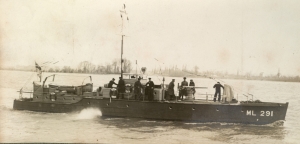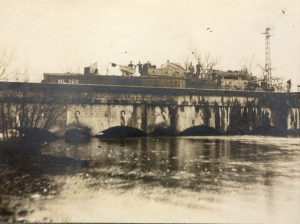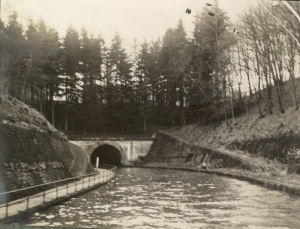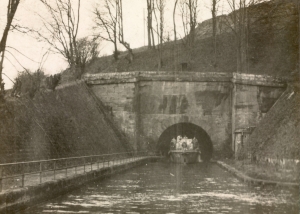The Rhine Patrol Flotilla
Part I: Establishment of the Flotilla
Many thanks to Paul Robinson for sharing the photographs brought home from the war and occupation by his grandfather, Lieut. John Robinson, DSO, RNVR. The majority of the pictures in this section are drawn from that album.
With the signing of the Armistice the Allied powers quickly moved to occupy the Rhineland. Control of the Allied bridgeheads on the eastern shore was obviously of importance, the bridgehead cities of Cologne (British), Coblenz (American) and Mayence (French) acting as headquarters for the respective powers.
Perhaps of lesser importance, but necessary for the overall strategy of controlling communications and commerce in the occupied territories was control of traffic on rivers and canals. Within days of the Armistice the Field Navigation Commission, headquartered at Nancy, was established to regulate all navigable waterways within the occupied territories including rivers and canals in Belgium, the Rhine between Alsace-Lorraine and the Dutch frontier, the Moselle from Alsace-Lorraine to its junction with the Rhine, and the Saar from Alsace-Lorraine to its junction with the Moselle.
In support of this the British and French deployed ships to their respective headquarter cities. Both relied upon the ML (the French navy having purchased forty ML's, or Vedettes as they termed them, from the Royal Navy during the war, plus an undetermined number directly from Elco).
Commander The Honorable PGEC Acheson, MVO, DSO, RN, received his sailing orders on 14 December 1918. He was to proceed to Cologne by way of the rivers and canals of France; departing on the 17th of the month with twelve ML's to comprise the Rhine Patrol Flotilla. Their course was an expedient imposed by the limitations of Dutch neutrality which prevented direct warship access via the Rhine.
Part I: Establishment of the Flotilla
Many thanks to Paul Robinson for sharing the photographs brought home from the war and occupation by his grandfather, Lieut. John Robinson, DSO, RNVR. The majority of the pictures in this section are drawn from that album.
With the signing of the Armistice the Allied powers quickly moved to occupy the Rhineland. Control of the Allied bridgeheads on the eastern shore was obviously of importance, the bridgehead cities of Cologne (British), Coblenz (American) and Mayence (French) acting as headquarters for the respective powers.
Perhaps of lesser importance, but necessary for the overall strategy of controlling communications and commerce in the occupied territories was control of traffic on rivers and canals. Within days of the Armistice the Field Navigation Commission, headquartered at Nancy, was established to regulate all navigable waterways within the occupied territories including rivers and canals in Belgium, the Rhine between Alsace-Lorraine and the Dutch frontier, the Moselle from Alsace-Lorraine to its junction with the Rhine, and the Saar from Alsace-Lorraine to its junction with the Moselle.
In support of this the British and French deployed ships to their respective headquarter cities. Both relied upon the ML (the French navy having purchased forty ML's, or Vedettes as they termed them, from the Royal Navy during the war, plus an undetermined number directly from Elco).
Commander The Honorable PGEC Acheson, MVO, DSO, RN, received his sailing orders on 14 December 1918. He was to proceed to Cologne by way of the rivers and canals of France; departing on the 17th of the month with twelve ML's to comprise the Rhine Patrol Flotilla. Their course was an expedient imposed by the limitations of Dutch neutrality which prevented direct warship access via the Rhine.
The passage of the fledgling Rhine Flotilla from Portsmouth to Le Havre on 22 December 1918 was adventurous, with two of the ML's lost. The first, ML 121, Lieut. John Robinson, DSC, RNVR, sank about fifteen miles down the coast from Le Havre on the Seine Bank. Robinson had been in command of the ML for all of eleven days, having come from ML 424 aboard which he had participated in the St. George's Day raid on Zeebrugge, earning a DSC for his actions. Later that day, ML 566 (commander unknown) foundered off Cape Barfleur.
At Le Havre the flotilla appears to have picked up two more ML's to bring the Flotilla back to complement. They continued up the Seine, through Paris, crossing to the Marne and on to Vitry-le-Francoise. Here they entered the Marne-Rhine Canal, passing through Nancy before arriving at Strasbourg to enter the Rhine. During much of their passage they dealt with poor weather and, in particular, severe flooding due to the heavy winter rains of 1918/1919. They were frequently forced to stop for a day or two while the water levels retreated enough for the ML's to fit beneath the stone bridges over the rivers and canals.
At Le Havre the flotilla appears to have picked up two more ML's to bring the Flotilla back to complement. They continued up the Seine, through Paris, crossing to the Marne and on to Vitry-le-Francoise. Here they entered the Marne-Rhine Canal, passing through Nancy before arriving at Strasbourg to enter the Rhine. During much of their passage they dealt with poor weather and, in particular, severe flooding due to the heavy winter rains of 1918/1919. They were frequently forced to stop for a day or two while the water levels retreated enough for the ML's to fit beneath the stone bridges over the rivers and canals.
Meanwhile, on 3 January 1919, Lieut. RG Fife, RNVR, received orders to proceed from Portsmouth with an additional four ML's (with at least one, ML 229, being commanded by Lieut. Robinson of the earlier, ill-fated ML 121). This second deployment was ordered to sail on 11 January 1919 following the same route as the main body of the Flotilla.
By the end of January the Rhine Flotilla was in Cologne with headquarters established at the appropriated facilities of the Cologne Watersports Club. This was built on a barge situated just to the south of the Hohenzollern Bridge along the Frankenwerft. Families soon joined those Flotilla officers able to live in rented housing.
By the end of January the Rhine Flotilla was in Cologne with headquarters established at the appropriated facilities of the Cologne Watersports Club. This was built on a barge situated just to the south of the Hohenzollern Bridge along the Frankenwerft. Families soon joined those Flotilla officers able to live in rented housing.





